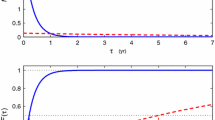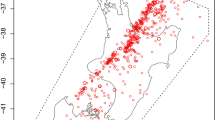Abstract
The Poisson process was tested for the sequence of earthquakes that occurred in and around the Korean Peninsula from 1980 through 2014, inclusive. The earthquake origin parameters by Korea Meteorological Administration (KMA) were used. Two statistical tests were applied: the Pearson’s Chi-square test for the earthquake frequency and the Kolmogorov-Smirnov test for the inter-event time. The two tests consistently showed the existence of m P , the minimum magnitude above which the null hypothesis of the Poisson process could not be rejected. At significance levels of 1, 5, and 10%, the m P was smaller than 2.7 for inland earthquakes and 3.1 for all earthquakes. It was concluded that the sequence of Korean earthquakes follows the Poisson process.
Similar content being viewed by others
References
Aki, K., 1956, Some problems in statistical seismology. Zisin, 8, 205–228.
Anagnos, T. and Kiremidjian, A.S., 1988, A review of earthquake occurrence models for seismic hazard analysis. Probabilistic Engineering Mechanics, 3, 3–11.
Choi, H., Hong, T.-K., He, X., and Baag, C.-E., 2012, Seismic evidence for reverse activation of a paleo-rifting system in the East Sea (Sea of Japan). Tectonophysics, 572–573, 123–133.
Cornell, C.A., 1968, Engineering seismic risk analysis. Bulletin of the Seismological Society of America, 58, 1583–1606.
Johnston, A.C., Coppersmith, K.J., Kanter, L.R., and Cornell, C.A., 1994, The earthquakes of stable continental regions, Volume 1: Assessment of large earthquake potential. TR-102261-V1, Electric Power Research Institute, California, 309 p.
Gardner, J.K. and Knopoff, L., 1974, Is the sequence of earthquake s in southern California, with aftershocks removed, Poissonian? Bulletin of the Seismological Society of America, 64, 1363–1367.
Habermann, R.R., 1982, Consistency of teleseismic reporting since 1963. Bulletin of the Seismological Society of America, 72, 93–112.
Hong, T.-K., Park, S., and Houng, S.E., 2015, Seismotectonic properties and zonation of the far-eastern Eurasian plate around Korean Peninsula. Pure and Applied Geophysics. doi 10.1007/s00024-015-1170-2
Kim, K.-H. and Park, Y., 2010, The 20 January 2007 ML 4.8 Odaesan earthquake and its implications for regional tectonics in Korea. Bulletin of the Seismological Society of America, 100, 1395–1405.
Kim, W.-Y., Choi, H., and Noh, M., 2010, The 20 January 2007 Odaesan, Korea, earthquake sequence: reactivation of a buried strike-slip fault? Bulletin of the Seismological Society of America, 100, 1120–1137.
Knopoff, L., 1964, The statistics of earthquakes in Southern California. Bulletin of the Seismological Society of America, 54, 1871–1873.
Korea Meteorological Administration (KMA), 2015, http://www.kma.go.kr/weather/earthquake_volcano/domesticlist.jsp.
Michael, A.J., 2011, Random variability explains apparent global clustering of large earthquake. Geophysical research Letters, 38, L21301.
Park, J.-C., Kim, W., Chung, T.W., Baag, C.-E., and Ree, J.-H., 2007, Focal mechanisms of recent earthquakes in the southern Korean Peninsula. Geophysical Journal International, 169, 1103–1114.
Parsons, T. and Geist, E.L., 2012, Were global M ≥ 8.3 earthquake time intervals random between 1900 and 2011? Bulletin of the Seismological Society of America, 102, 1583–1592.
Press, W.H., Flannery, B.P., Teukolsky, S.A., and Vetterling, W.T., 1986, Numerical Recipes. Cambridge University Press, New York, 818 p.
Rydelek, P.A. and Sacks, I.S., 1989, Testing the completeness of earthquake catalogs and the hypothesis of self-similarity. Nature, 337, 251–253.
Shlein, S. and Toksöz, M.N., 1970, A clustering model for earthquake occurrences. Bulletin of the Seismological Society of America, 60, 1765–1787.
Spiegel, M.R., 1981, Theory and problems of statistics. Schaum’s outline series, SI (metric) edition, McGraw-Hill Book Co., Singapore, 359 p.
Stein, R.S. and Hanks, T.C., 1998, M ≥ 6 earthquakes in southern California during the twentieth century: no evidence for a seismicity or moment deficit. Bulletin of the Seismological Society of America, 88, 635–652.
Stepp, J.C., 1972, Analysis of completeness of the earthquake sample in the Puget Sound area and its effects on statistical estimates of earthquake hazard. Proceedings of the International Conference on Microzonation for Safer Construction Research and Application, Seattle, October 30–November 3, 2, p. 897–909.
Wang, J.-P., Huang, D., Chang, S.-C., and Wu, Y.-M., 2014, New evidence and perspective to the Poisson process and earthquake temporal distribution from 55,000 events around Taiwan since 1900. Natural Hazards Review, 15, 38–47.
Weichert, D.H., 1980, Estimation of the earthquake recurrence parameters for unequal observation periods for different magnitude. Bulletin of the Seismological Society of America, 70, 1337–1346.
Wyss, M. and Toya, Y., 2000, Is background seismicity produced at a stationary Poissonian rate? Bulletin of the Seismological Society of America, 90, 1174–1187.
Author information
Authors and Affiliations
Corresponding author
Rights and permissions
About this article
Cite this article
Noh, M. On the Poisson process of the Korean earthquakes. Geosci J 20, 775–779 (2016). https://doi.org/10.1007/s12303-016-0012-2
Received:
Accepted:
Published:
Issue Date:
DOI: https://doi.org/10.1007/s12303-016-0012-2




